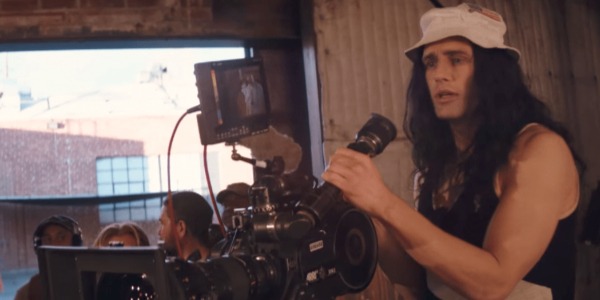The Troubling Scene THE DISASTER ARTIST Must Reckon With

Kyle is a film geek and a film major graduate…
Leading up to its release, The Disaster Artist was being lauded as a touching ode to friendship and an artist’s unending passion. With the screenwriting pair behind The Spectacular Now and 500 Days of Summer, the eccentric James Franco directing and starring, and the unbelievable story of The Room’s Tommy Wiseau, the film became one of the most anticipated of 2017 for many.
The Florence Foster Jenkins Comparison
For a while, it was one of mine too. But then, a critic compared it to Florence Foster Jenkins, and an uneasiness started to build in me. I’m one of the few that genuinely dislikes the Meryl Streep film. It seemed like a story not worth telling, that this rich white woman, so terrible at singing, earned praise and success because she was so rich that her friend could buy her fans for her.
The film is not only muddled in regard to privilege, but it’s difficult to engage with the character because so much of viewers’ allegiance depends on feeling bad for her. If you don’t feel bad for her, there goes the whole film.

I feared the same with The Disaster Artist, and I knew that I couldn’t see it without holding the film to the same standards. But I saw it anyway. Everyone was loving it. I didn’t.
As portrayed in the movie, Wiseau mysteriously has a lot of money and buys the opportunity to make his film. The result of The Room is, well, terrible, as most do believe, but Wiseau becomes celebrated in spite of that. It’s difficult to fall in love with the character when so much of the endearment is offset by these unconfronted aspects of privilege. If a woman had made The Room, would she be celebrated like Wiseau is?
How The Disaster Artist Parallels The James Franco Allegations
But The Disaster Artist is more troubling than just its faulty character framing. It’s a truly uncomfortable film, and not for good reason. And when the sexual misconduct allegations came out against James Franco just a few days after I saw the film, the reasons became even more uncomfortable.
The film itself does not sufficiently confront the misconduct by the character of Tommy Wiseau. Toward the middle of the film, as The Room is in the midst of production, Wiseau emerges to film a sex scene, nearly naked except for some skim cover-up. Based on costar Greg’s (Dave Franco) reaction, the extent of Tommy’s de-robing is a surprise, but Wiseau proceeds to get on top of the actress, Juliette (Ari Graynor), and then suggest that her skin is too ugly for the scene.
Despite the chance that the moment was exaggerated or fabricated for The Disaster Artist, the film still has a responsibility with what it presents. And in that moment, it seemed to tip overboard. The response to Wiseau’s actions was disgust, but by Greg and the crew. Juliette was barely given a reaction.
And the only time the moment comes up again is during the screening of The Room at the end of the film, when the audience reacts negatively and Juliette is horrified in embarrassment.

Strangely, the action also seems similar to the allegations made against Franco — a director’s inappropriate treatment of an actress during a sex scene. In the moment in the film, Wiseau abuses his power and disregards the well-being of Juliette during a very sensitive moment on set. This behavior seems to be the exact type that the #MeToo movement has been working to get rid of.
Forced Sympathy Doesn’t Work
And not that a character could be redeemed from such a moment, but The Disaster Artist relies on the same forced sympathy that Florence Foster Jenkins does, by making viewers feel bad for the character. When The Room screens during the final act, the film overtly overwhelms us with an onslaught of close-ups of laughter by the diegetic audience. The construction of the scene evokes horror, even, at how frighteningly intense the mocking becomes. So, when Greg tries to comfort Tommy, it’s easy to get wrapped up in a kind of sympathy that the film almost physically pulls out of us.
We Have To Talk About It
Even if there was an actual moment of reckoning for Wiseau in The Disaster Artist, if he, as a character, were forced to confront how poorly he behaved on set, it likely still wouldn’t have been sufficient due to that one scene. And in this moment in time, as so many of us work to empower women and rid not only the film industry, but all of society of the abuse it has ignored for far too long, it would be irresponsible to ignore the presence of such troubling aspects in this film, especially considering the troubling man who directed it.
What do you think of this particular scene from The Disaster Artist and how the film deals with it? Discuss in the comments!
Does content like this matter to you?
Become a Member and support film journalism. Unlock access to all of Film Inquiry`s great articles. Join a community of like-minded readers who are passionate about cinema - get access to our private members Network, give back to independent filmmakers, and more.
Kyle is a film geek and a film major graduate from UC Berkeley. Aside from obsessively monitoring the awards season or watching a Christopher Nolan film for the twentieth time, he loves screenwriting and the Los Angeles Dodgers.













